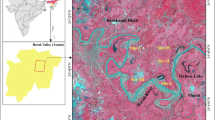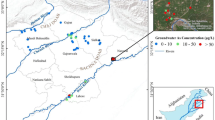Abstract
This study examined the spatial distribution of total mercury (THg) and total arsenic (TAs) in water, soil and cassava (Manihot esculenta) (leaves and roots) samples taken from areas in Rwamagasa village in northwestern Tanzania where daily living activities occur in close proximity to extensive artisanal and small scale gold mining. Results indicated that 33.3 % of the water sources had THg levels above the WHO guideline of 1.0 µg/L for safe drinking water, and 12.5 % had TAs levels above 10 µg/L. Cassava leaves were found to have higher THg (ranging from 8.3 to 167 µg/kg) and TAs (ranging from 60 to 1,120 µg/kg) levels than cassava roots, which ranged between 1.2–8.3 µg/kg for THg and 25–310 µg/kg for TAs. Concentrations of THg and TAs in soil samples ranged between 5.8–1,759 and 183–20,298 µg/kg, respectively. Both THg and TAs were found to be distributed throughout Rwamagasa village.


Similar content being viewed by others
References
Adjorlolo-Gasokpoh A, Golow AA, Kambo-Dorsa J (2012) Mercury in the surface soil and cassava, Manihot esculenta (flesh, leaves and peel) near goldmines at Bogoso and Prestea, Ghana. Bull Environ Contam Toxicol 89:1106–1110
Alloway BJ, Ayres DC (1994) Chemical principles of environmental pollution. London: Blackie Academic and Professional
British Columbia (2010) Recommended guidance and checklist for ecological risk assessment of contaminated sites in British Columbia—Chapter 6.Urban Park. http://www.env.gov.bc.ca/epd/remediation/policy_procedure_protocol/protocols/tier1/chapter6.htm. Accessed 20 June 2013
Campbell LM, Hecky RE, Muggide R, Dixon DG, Ramlal PS (2003) Variation and distribution of total mercury in water, sediment and soil from northern Lake Victoria, East Africa. Biogeochemistry 65:195–211
Eaton AD, Clesceri LS, Rice EW, Greenberg AE (Eds) (2005) Standard methods for the examination of water and wastewater. 21st edition. Washington, D.C.: American Public Health Association: Method 3111B, D, 3112B & 3114B.3:19–34. American Public Health Association (APHA), American Water Works Association (AWWA), Water Environmental Federation (WEF)
Environmental Agency (2009a) Contaminants in soil: updated collation of toxicological data and intake values for humans. Mercury. Science Report SC 050021/SR TOX 7. Environmental Agency, Bristol
Environmental Systems Research Institute (ESRI) (2010) ArcGIS 9.2. ESRI, Redlands
Essumang DK, Dodoo DK, Obiri S, Yaney JY (2007) Arsenic, cadmium and mercury in cocoyam (Xanthosoma sagittifolium) and wateryam (Colocasia esculenta) in Tarkwa a mining community. Bull Environ Contam Toxicol 79(4):377–397
Geological Survey of Denmark and Greenland—GEUS (2000) Small scale mining. http://www.geus.dk/program-areas/common/int_tz01-uk.html. Accessed 20 June 2012
Golden Software Inc (2010) Surfer 9. Golden Software Inc, Golden
Ikingura JR, Akagi H, Mujumba J, Messo C (2006) Environmental assessment of mercury dispersion, transformation and bioavailability in the Lake Victoria Goldfields, Tanzania. J Environ Manage 81:167–173
ILO (1999) Social and labour issues in small-scale mines. Report for discussion at the tripartite meeting on social and labour issues in small-scale mining (TMSSM). International Labour Office, Geneva
Jønsson JB, Bryceson DF (2009) Rushing for gold: mobility and small scale mining in East Africa. Dev Change 40(2):249–279
Keshavarzi B, Moore F, Rastmanesh F, Kermani M (2012) Arsenic in the Muteh gold mining district, Isfahan, Iran. Environ Earth Sci 67:959–970
Leonard TL, Taylor GE, Gustin MS, Fernandez GCJ (1998) Mercury and plants in contaminated soils: uptake, partitioning, and emission to the atmosphere. Environ Toxicol Chem 17(10):2063–2071
Smedley PL, Edmunds WM, Pelig-Ba KB (1996) Mobility of arsenic in groundwater in the Obuasi gold-mining area Ghana: some implications for human health. In: Appleton JD, Fuge R, McCall GJH (eds) Environmental geochemistry and health, geological society special publication, vol 113. Chapman & Hall, London, pp 163–181
Tanzania Bureau of Standards (TBS) (2003) National Environmental Standards: TZS789:2003—Drinking (Portable) water—specification. Tanzania Dar es Salaam: Bureau of Standards
Tanzanian Land and Survey Dept (1994) Quarter Degree Sheet (QDS) 46/1 1:50, 0000. Government of Japan (JICA), For the Government of the United Republic of Tanzania. Dar es Salaam
Taylor H, Appleton JD, Lister R, Smith B, Chitamweba D, Mkumbo O (2005) Environmental assessment of mercury contamination from the Rwamagasa artisanal gold mining centre, Geita District Tanzania. Sci Total Environ 343(1–3):111–133
U.S. Environmental Protection Agency (EPA) (1994) Standard operating procedure (SOP) for sampling in hazardous waste sites. Terrestrial plant sampling guidance. SOP#: 2037 Rev. 0.0. 19/10/1994. http://clu-in.org/download/ert/2037-R00.pdf. Accessed 15 May 2012
Van Straaten P (2000) Human exposure to mercury due to small scale gold mining in northern Tanzania. Sci Total Environ 259(1–3):45–53
Wagner S (2003) Socio-economic survey of Rwamagasa mining site in Geita district. Removal of Barriers to Introduction of Cleaner Artisanal Gold Mining and Extraction Technologies UNIDO—Socio-Economic Survey of Rwamagasa Mining Site in Geita District, Tanzania. Vienna, Austria: Global Mercury Project. GEF/UNDP/UNIDO, pp 3–5. http://www.unites.uqam.ca/gmf/intranet/gmp/countries/tanzania/sociological_report/Tanzania_Sociological_Report.pdf. Accessed 15 Mar 2012
WHO (2004) Guideline for drinking water quality, vol 1. World Health Organization, Geneva. http://www.who.int/water_sanitation_health/dwq/fulltext.pdf. Accessed 12 Dec 2011
Acknowledgments
The authors acknowledge the Catholic University of Health and Allied Sciences-Bugando, the University of Calgary and the University of Colorado, Denver. A special thank you goes to African Eagle Resources who contributed funding to support this project. The authors would also like to thank all the participants in this study. The authors also declare that they have no competing interests. It should be noted that Twigg Gold is not engaged or associated with artisanal mining in the Rwamagasa belt or anywhere else.
Author information
Authors and Affiliations
Corresponding author
Rights and permissions
About this article
Cite this article
Nyanza, E.C., Dewey, D., Thomas, D.S.K. et al. Spatial Distribution of Mercury and Arsenic Levels in Water, Soil and Cassava Plants in a Community with Long History of Gold Mining in Tanzania. Bull Environ Contam Toxicol 93, 716–721 (2014). https://doi.org/10.1007/s00128-014-1315-5
Received:
Accepted:
Published:
Issue Date:
DOI: https://doi.org/10.1007/s00128-014-1315-5




